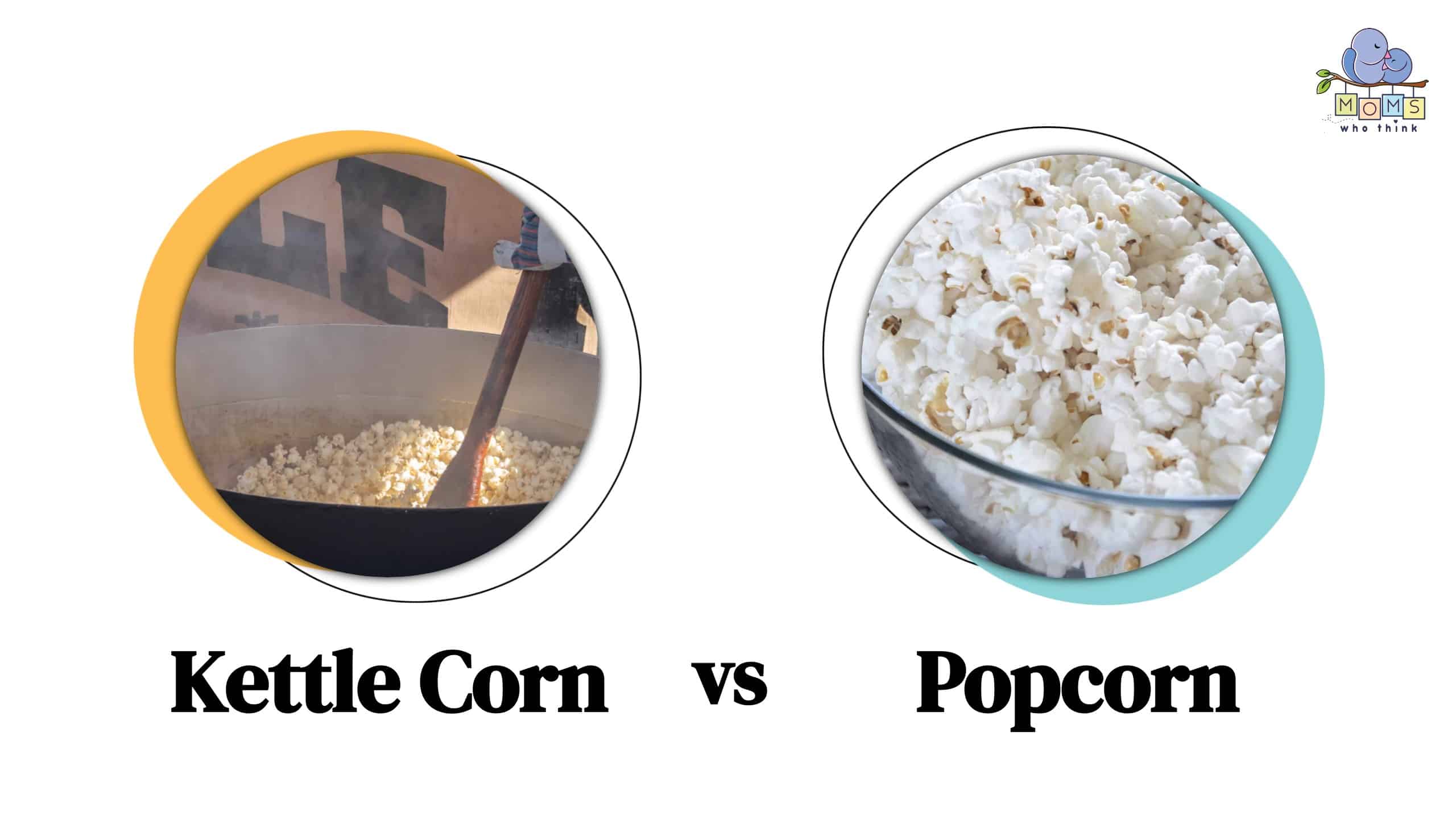Kettle corn is a type of corn that was traditionally cooked in a huge iron kettle that had been oiled beforehand. Popcorn is given a unique flavor and texture from a combination of sugar and salt after it has popped.
Popcorn kernels of the regular variety are bred to explode and puff when heated, releasing the moisture contained therein. Thus, the moniker. The key distinctions between kettle popcorn and normal popcorn are as follows:
Is There Any Significant Difference Between Popcorn and Kettle Corn Kernels and Regular Corn?
Popcorn is made from a specific corn kernel, but many people probably don't give it much thought or assume that any old corn kernel will do. However, unlike popcorn or kettle corn, normal corn kernels don't pop. These corn kernels have been modified to explode upon contact with high temperatures.

Popcorn is a popular snacking option during movies.
©Dean Drobot/Shutterstock.com
History
Popcorn was manufactured from maize as early as 3600 BC, making it clear that corn was an important crop in pre-Columbian Mexico. Popcorn gained widespread popularity in the mid-19th century when it was included in Cracker Jack. Following the creation of the popcorn machine during the 1890s, its dispersion and prominence experienced a significant surge. Throughout the Great Depression and World War 2, it served as a prevalent dietary item. It remains a top-performing snack in the US market.
Kettle corn, like popcorn, saw its heyday in the 18th century. It was created in Pennsylvania by Dutch colonists. The early 21st century saw a surge in popularity, and now it is commonly seen at fairs, flea markets, and craft events.
Flavor
Traditional home-popped popcorn requires a saucepan, oil, and high heat. Popcorn, typically seasoned with salt and butter, has become a standard in movie theaters and as a thoughtless snack for watching TV at home. Kettle corn, on the other hand, transforms the savory snack into a sweet treat that can be customized with any flavorings you like.
Salty vs. Sweet
The flavor of the corn is distinctively altered when it is popped in the air as opposed to oil. Popcorn is a popular salty snack that can be flavored in various ways, including cheese and cinnamon. Popcorn has a neutral flavor that the addition of seasoning can somewhat alter.
Kettle corn is primarily sweet, with a very slight salty aftertaste. Adding sugar to your mixture while cooking is crucial for creating a balanced sweet and salty flavor. The distinctive taste is what makes kettle corn so well-known. Kettle Corn is a tasty snack in various flavors to suit individual tastes.
Methods of Preparation
Popcorn preparation is very different from kettle corn preparation. The only common ground between the two methods is maize that swells when heated. Other cooking techniques provide chefs with various ingredients, resulting in various finished snacks.
To pop in oil or air?
Popcorn's traditional cooking methods have altered little over the years. Popcorn typically arrives pre-packaged and may be cooked in virtually any microwave. Popcorn is a healthy snack, but it takes a lot of oil to fry. The popcorn you buy from the machines in the theater is made using a mixture of steam and oil.
Butter stations are scattered throughout the foyer, where you may add as much butter as you like to your steam and oil popcorn. The preparation of kettle corn at home is conventionally executed in a cast-iron kettle, although Dutch ovens are also a viable option.
The ingredients comprising sugar, oil, salt, and corn kernels are mixed within the cast-iron cauldron and subjected to the acquired heating protocols. Due to the easy combustibility of sugar, it is necessary to continuously agitate the mixture to avoid an unsavory bitterness in the result.
Benefits to Your Health
Analyzing the nutritional value of popcorn and kettle corn can pose a challenge. The quantitative impact of sugar, salt, butter, and artificial flavorings on the dish during the cooking process influences its comparative analysis. To determine the brand of popcorn or kettle corn with the highest nutritional value, examine the nutrition labels.
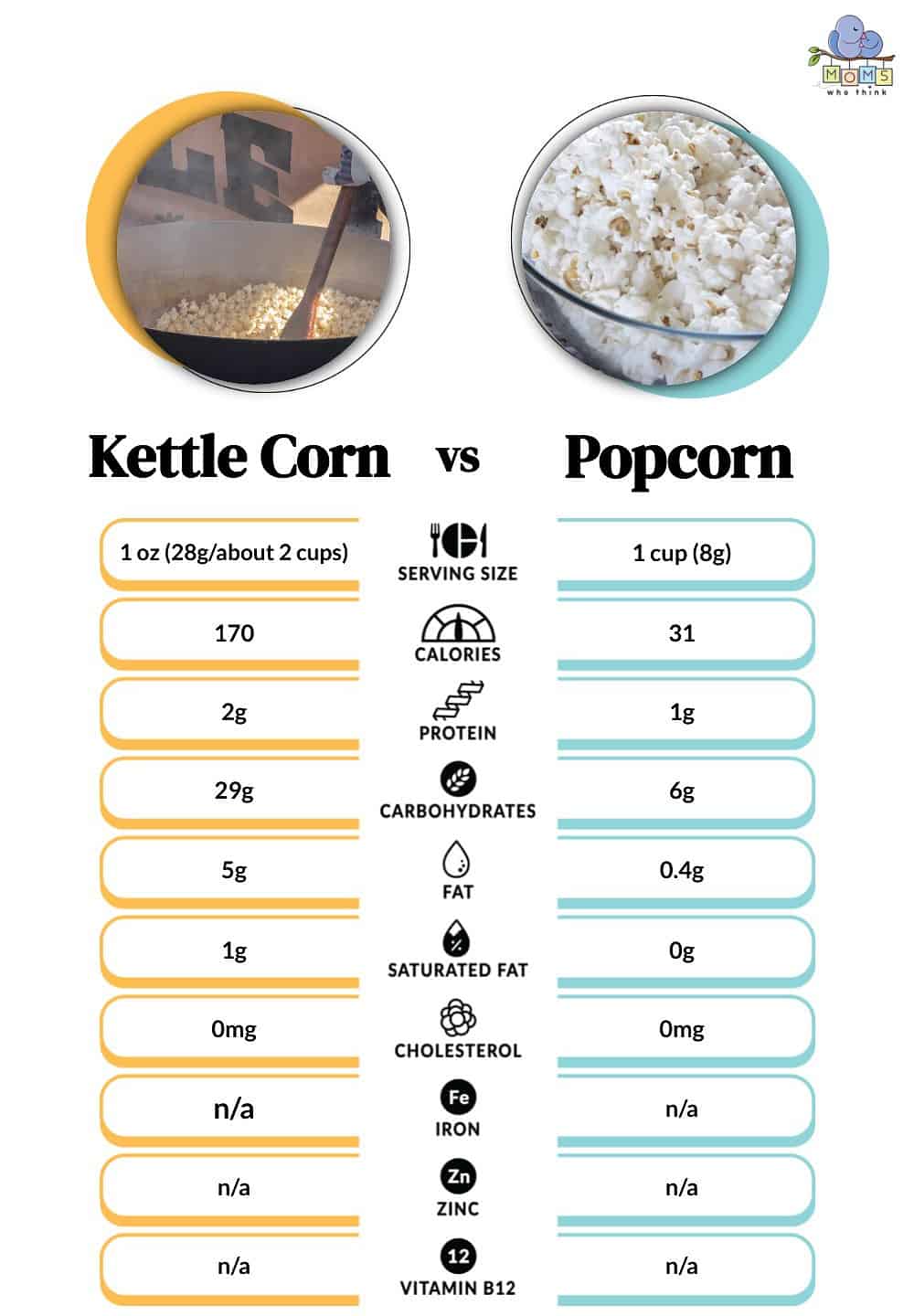
©
What Effect Do Different Cooking Methods Have On Nutritional Value?
You may make a nutritious snack by cooking the corn using the ‘air popping' method and seasoning it with very little salt. Using a hot air popper appliance or the top of the stove are the two most typical methods of air popping.
Popcorn kernels include a wealth of fiber and antioxidants because they are whole grains. Due to their inherent minimal sugar levels, they are correspondingly deficient in calories. However, subjecting it to considerable amounts of oil and butter may result in a single serving containing up to 29 grams of saturated fat, equivalent to half your daily threshold. Make the most use of the balance between a delectable treat and a nourishing one by meticulously curating your flavorings and culinary oils.
So, What Exactly Is Kettle Corn?
Popcorn, known as “kettle corn,” is often prepared in heavy pots made of cast iron. Popcorn with a little coating of sweetness is usually produced with just oil and white sugar, although other sugars and sweeteners can be added to suit individual preferences.
Recipe for Kettle Corn
Ingredients for Kettle Corn
To create this delicious and simple kettle corn, you will need:
- Half a cup of unpopped popcorn kernels yields around 10 cups of kettle corn.
- Oil: Sugar needs something to cling to, and a neutral oil like vegetable oil does the trick without changing the flavor.
- White sugar is all that's needed to sweeten this kettle corn.
Directions
Put some heated oil in a pan. Try it out by placing three kernels of popcorn in a covered pot of oil and heating it over medium heat. The oil is ready when you hear the kernels pop. The subsequent steps are quick, so have all the ingredients within easy reach of the stove.
Put on some oven mitts, cover the saucepan, and give it a good stir as soon as you add the sugar and popcorn. Perform the subsequent action by energetically agitating and oscillating the container until the gaps amid the bursts extend to approximately 1-2 seconds. (If the heating process exceeds the optimal duration, the sugar may burn. Hence it is advisable to prioritize caution over regret.)
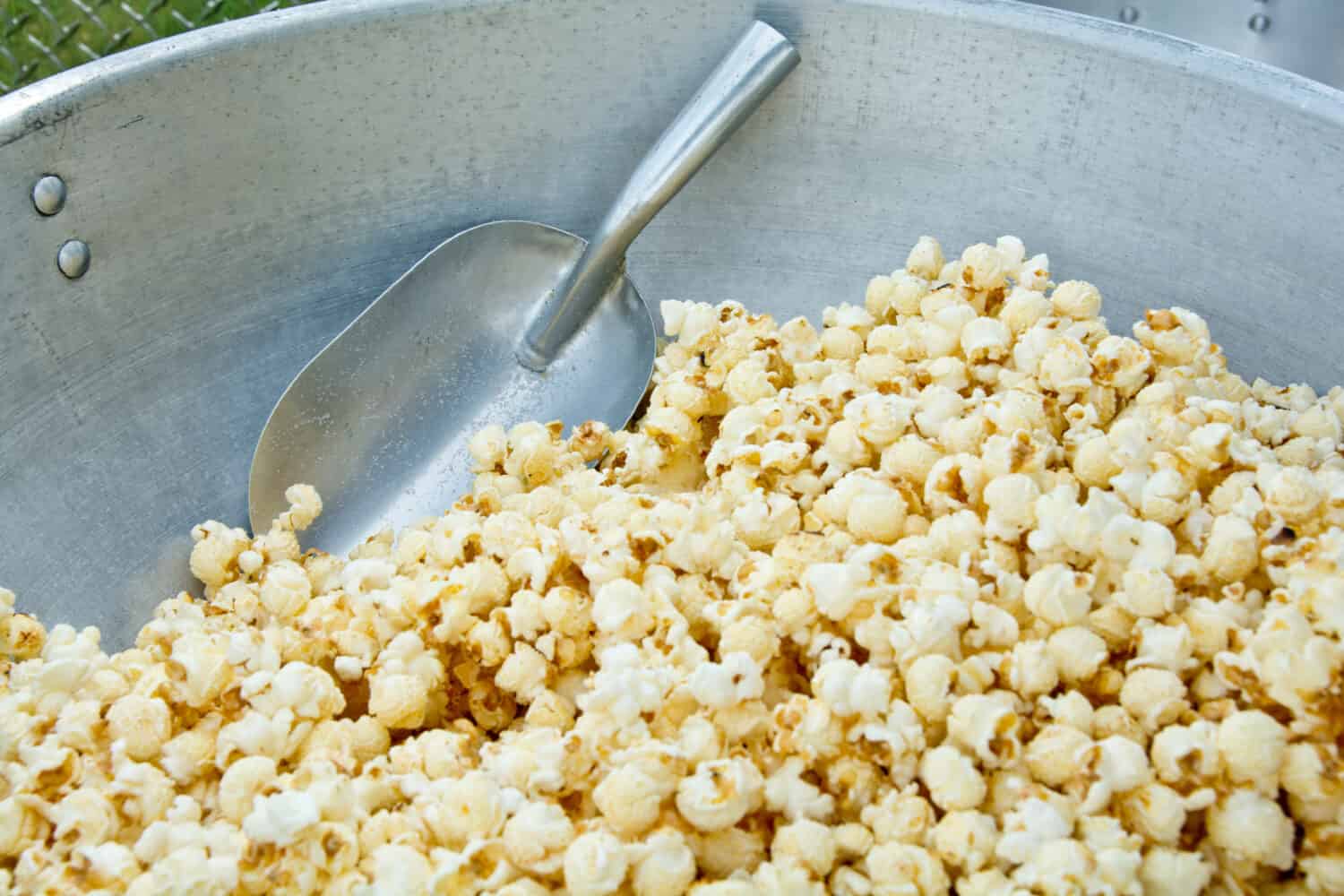
With the right ingredients and a little patience, you too can make kettle corn and popcorn at home!
©Erika J Mitchell/Shutterstock.com
When the popping sound stops, remove the pot from the heat source and temporarily place it in a different location.
Mix the popped corn with salt and allow it to decrease in temperature in a large and flat container. Through a delay, the sugar crystals may undergo a transformation resulting in a firm outer layer.
Recommendations When Preparing
At the moment when the popping frequency slows down to one occurrence per two seconds, remove the pan from the heat source and consistently mix it within a soup pot with a weighty make.
Unexploded corn kernels cannot descend to the lowermost part of the container as they typically would in traditional popcorn; exercise care while chewing on any foreign particles that are discovered.
- For the production of 12 to 14 cups of popcorn, it is recommended to increase the oil quantity to 2 tablespoons, the corn kernels to 1/2 cup, the sugar to 1/4 cup, and the salt to 3/4 to 1 teaspoon.
- Try any of these resolutions if you have sweetened corn that resists effortless elimination after immersion.
Changes to the Recipe
To achieve a sweetened flavor, opt for light brown sugar instead of white sugar. Enhance dishes' flavor profiles by substituting regular salt with truffle salt, smoked salt, Old Bay seasoning, or garlic salt to create sweet and savory tastes.
Combine chili powder and salt, then distribute them evenly on the kettle corn. Use a small amount of ground cinnamon or pumpkin pie spice alongside the salt when making kettle corn to impart a pleasant spiced taste.

Flavored or plain, popcorn is a snack even keto dieters can indulge in.
©Prostock-studio/Shutterstock.com
Tips for Storage
Despite the desirability of being fresh, kettle corn can be preserved for a maximum of 14 days in a sealed can. Kettle corn preservation can be achieved by introducing a food-safe desiccant packet, similar to the ones found in nori seaweed packaging, into the case.
In case of stale popcorn, disperse it on a baking sheet lined with foil or parchment paper and warm it in an oven preheated to 250 degrees Fahrenheit for 5 to 10 minutes. Additional popped corn may serve as a condiment for liquid and leafy dishes.
Combine liquefied chocolate chips, brown sugar, and butter to produce zebra popcorn. The formula for making the salted caramel popcorn cheesecake is not difficult. When the sound emission goes down to a frequency of one pop per two seconds, remove the container from the source of heat and consistently mix it within a soup pot that has a sturdy base.
The unexploded corn kernels may not submerge into the pan's base as typically with traditional popcorn; chew any other pieces carefully. If you want to produce 12 to 14 cups of popcorn, the oil should be increased to 2 tablespoons, the corn kernels to ½ cup, the sugar to 1/4 cup, and the salt to 3/4 to 1 teaspoon. Try any of these options and watch your kitchen’s atmosphere fill up with a savory smell.
What is Popcorn?
Popcorn is corn (maize) whose kernels expand into massive fluffy masses when heated or microwaved. About 25 distinct species of Zea mays can be used to make popcorn, with the two most common being rice popcorn (with its pointed base and apex) and pearl popcorn (with its spherical, compact grains). Inside a popcorn kernel's tough hull and outer endosperm is a mound of the wet, starchy, white endosperm.
About 13.5% relative humidity is ideal. These kernels expand 20-40 times their original size when heated at roughly 400 °F (about 200 °C), at which point the moisture in the starch converts into steam, and the pressure inside the kernel explodes.
The Western Hemisphere is where popcorn first appeared. Popcorn kernels dating back a thousand years have been unearthed in Peru and Utah. Popcorn was toasted for eating, scattered during religious ceremonies, and worn as a hair ornament by Native Americans, according to accounts written by the earliest European travelers to the New World. The United States is now the world leader in popcorn production.
Popcorn with butter and salt is a popular snack. Instead, it can be covered in melted cheese, peanuts, almonds, or glazed with hard candy syrups of varying flavors and colors.
How to Prepare Popcorn
Are you looking for a flavor enhancer besides salt and butter? Add some freshly grated Parmesan cheese for a tasty twist. To spice things up, add some smoked paprika, cayenne powder, curry powder, taco seasoning, or nutritional yeast.
Before heating oil, make sure the inside of the pot is entirely dry to prevent sputtering.
Ingredients
- Three tablespoons of virgin coconut oil or olive oil
- Ingredients: 13 cup premium popcorn kernels
- Optional: More butter to taste, around one tablespoon
- Added salt
Procedure
- Oil should be heated in a 3-quart pot with a heavy bottom over medium heat. Coconut oil, if solid, should be melted completely before use.
- Throw in a few kernels of popcorn and heat the oil.
- Be patient while the popcorn pops.
- Pop 3–4 kernels of popcorn in hot oil.
- When the popping slows, spread out an additional 1/3 cup of popcorn kernels in a single layer.
- Hold your breath until the popcorn pops.
- Add the remaining kernels in a single layer when the popping has stopped.
- Put the lid on the pan, take it off the burner, and wait 30 seconds:
- When using this technique, the oil is heated to the proper temperature first, and then the remaining kernels are allowed to cool for 30 seconds, bringing them to a nearly popping temperature.
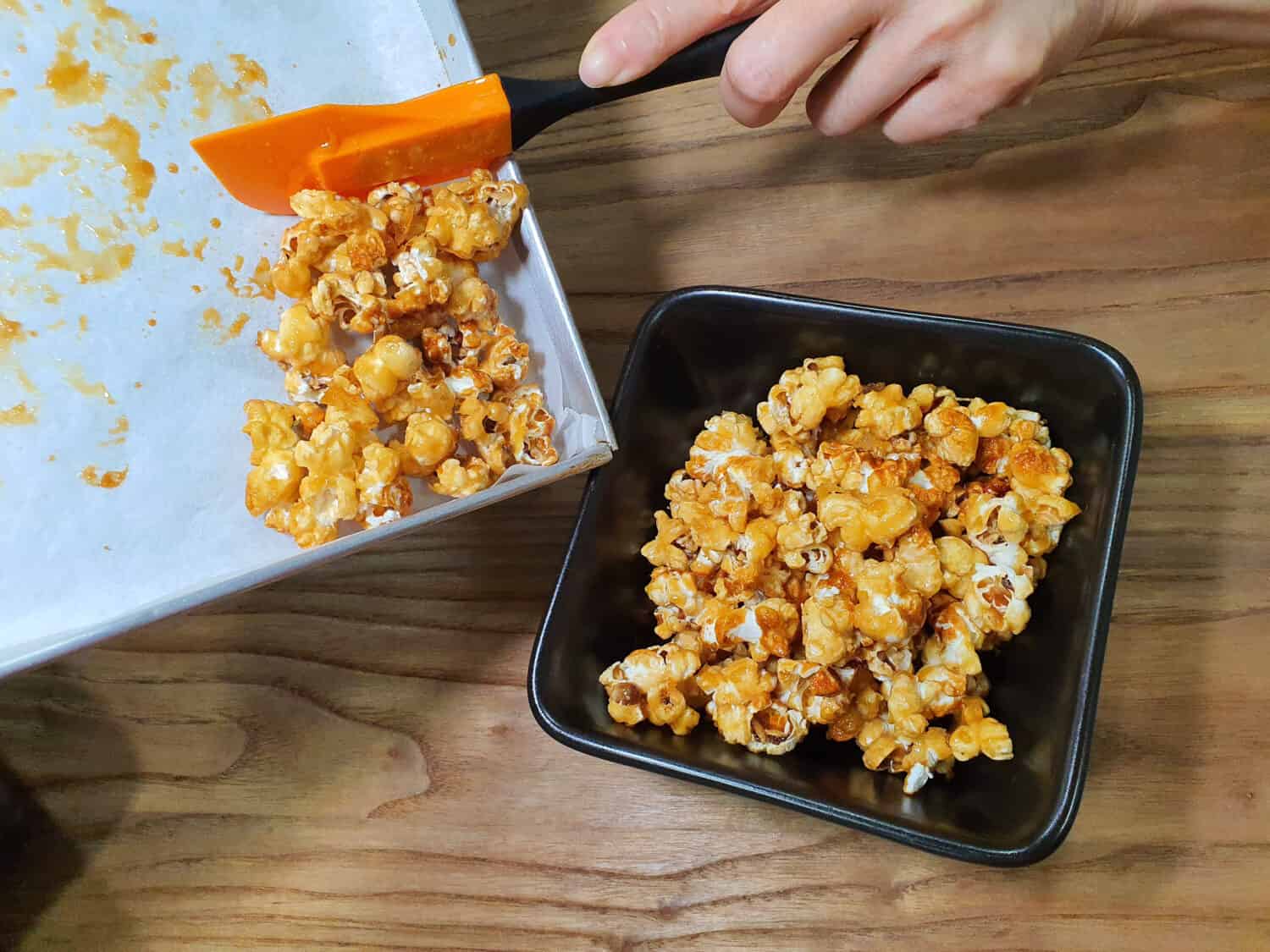
Once your popcorn is ready, flavor as desired and enjoy!
©Toshio Chan/Shutterstock.com
Popcorn should start popping quickly and all at once so put the pan back on the stove. When the popping becomes more noticeable, shake the pan over the flame slightly.
Key Takeaways To Make Your Popcorn More Delicious
The following are tips to look out for whenever you want to pop some popcorn.
- Keep the lid slightly ajar as the popcorn pops; this will allow steam to escape, making for crispier, drier popcorn.
- As soon as the intervals between pops lengthen to several seconds, take the pan off the heat.
- Take off the top and pour the popcorn into a large bowl.
- This method ensures that almost all kernels will pop, and nothing will catch fire.
- Put the popcorn in a serving bowl as soon as it's popped.
- Take the popcorn off the flame as soon as the popping slows down.
- Add butter and melt it in the hot, now empty pan. If you're using butter, this is the easiest way to do it.
- Butter up the popcorn for a tasty topping.
- If you allow the butter to brown slightly, the butter and popcorn will take on an even deeper, more buttery flavor.
- The melted butter may be easily added to the popcorn and then tossed to distribute it evenly.
- Add salt to taste the popcorn.
- Ingredients to spice up your popcorn: Paprika from Spain, yeast extract, cayenne pepper, chili pepper, curry powder, cumin, and Parmesan gratings.
Is Popcorn Okay With a Keto Diet?
The ketogenic diet is one that ensures low carbohydrate intake and high fat eating plan that has recently gained popularity. Popcorn is acceptable on the ketogenic diet. With only 106 calories and 5 grams of carbs per cup, popcorn is a keto-friendly snack. However, a large serving of popcorn may use a significant percentage of a keto dieter's daily carbohydrate allowance.
Popcorn is a wonderful choice for those on the ketogenic diet because it may be used as a replacement for other high-carb foods. Popcorn's crunch can help when desiring something crunchy, like chips or crackers. Popcorn with added sugar can help you fulfill your sweet taste without sabotaging your ketogenic diet.
A Quick Comparison of Kettle Corn vs. Popcorn
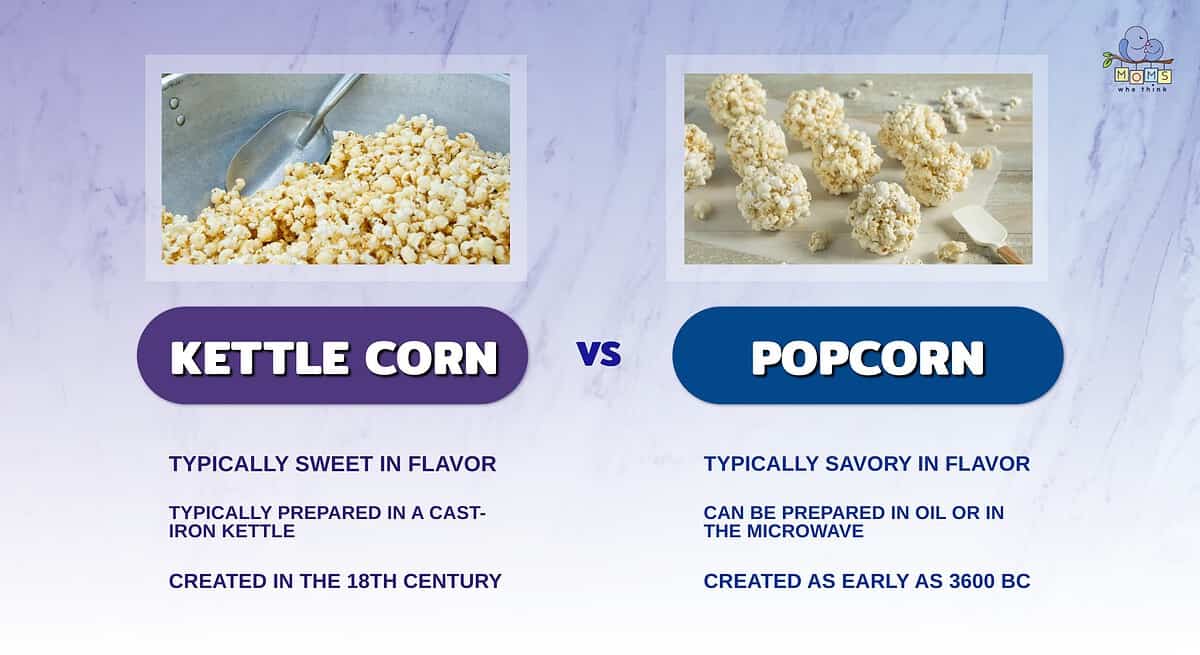
Popcorn is a popular snack for movie time, with its buttery and savory flavors being enjoyed by many. It's relatively easy to prepare at home with the advent of microwave popcorn, or you can prepare it the traditional way with oil. Kettle corn is sweeter than popcorn, and often comes in a variety of flavors. You can make it at home with a cast-iron kettle. Popcorn was first popped around 3600 BC, making it one of the world's oldest snacks. Kettle corn is much younger, having come around in the 18th century. Which snack you pick depends on your preferences- are you a salty kind of person, or a sweet kind of person? Whichever choice you make, both of these snacks are absolutely delicious.
Take a look at this colored popcorn recipe:

Colored Popcorn
Ingredients
For each batch:
1 tablespoon butter
1 tablespoon canola oil
1/4 cup light corn syrup
1/4 teaspoon liquid food coloring (add more for darker colors, less for lighter colors)
1/4 teaspoon kosher salt
1/3 cup unpopped popcorn kernels
Instructions
1. In a large microwave safe glass bowl, melt butter for 30-40 seconds until melted.
2. Add oil, corn syrup, food coloring, and salt. Mix well.
3. Add unpopped kernels and stir well, making sure each kernel is coated well.
4. Cover bowl with plastic wrap, allowing venting. Microwave on high for 4 to 5 minutes, stirring halfway through.
5. Once popped, pour the popcorn on a sheet of waxed paper and cool. Allow bowl to cool slightly between batches and wipe clean with a wet paper towel. Repeat for additional colors.
